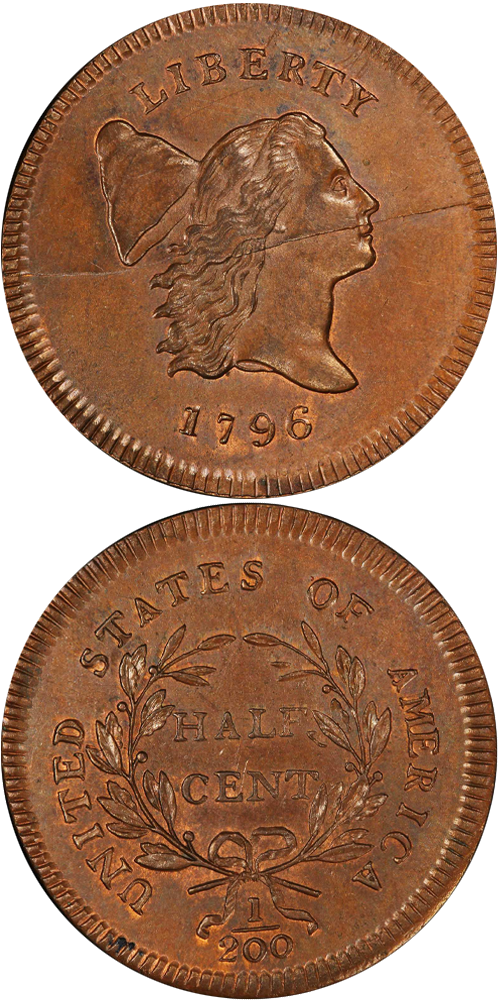1796 Liberty Cap Half Cent
No Pole
Instantly recognizable as there is no pole to the cap and a heavy bisecting crack is always present (see below). The digit 1 in the date is normal, i.e., it is not a letter I as used on the obverse die of the 1795 No Pole varieties, proving that the 1796 No Pole was struck from a different die, here in its only known pairing. A Single leaf at the top of each branch in the wreath appears on the reverse, four berries on the left branch, three on the right branch; there is a berry on the left side of the bow, but not on the right side. A leaf point is directly below the letter I in UNITED. This die was also used in the 1796 C-2 pairing.
Cohen-1 corresponds to the No Pole Guide Book variety of the 1796 half cent.
After only the 1797 Gripped Edge (which is less well known outside of the community of dedicated early copper enthusiasts), the 1796 No Pole is the rarest Guide Book variety in the half cent series. Many numismatists consider this the ultimate half cent, and it has been eagerly sought by collectors since the late 19th century, if not earlier. According to Breen, Dr. Montroville Dickeson knew of the 1796 No Pole in 1859 as he mentioned two varieties of the date. The earliest known auction appearance, however, was in W. Elliott Woodward's October 1880 sale of the Ferguson Haines Collection, lot 416. Mr. Haines had acquired the coin from Scott & Co. two years earlier for $36.
Fast forwarding to the late 20th century, the 1796 No Pole became the first half cent to sell for more than half a million dollars when the fabulous Eliasberg specimen realized $506,000 as lot 407 in our (Bowers and Merena's) May 1996 sale of that collection. That coin, universally ranked as CC#1 for the variety, was subsequently certified MS-67 RB by PCGS and brought $763,750 in our February 2016 sale of the D. Brent Pogue Collection, Part III.
In the April 2012 issue of Penny-Wise (journal of the Early American Coppers Club), Michael Spurlock accounted for 26 positively identified discrete specimens from these dies, along with several other untraced auction appearances over the last 150 years. Just nine specimens were reported in the 2005 1/200 survey of notable half cent collections, and only two examples were displayed during this variety's EAC Half Cent Happening appearance in 2014. A few other Mint State examples rank behind the Eliasberg-Pogue specimen in the Condition Census, including the Missouri Cabinet specimen (PCGS MS-65 BN), the John Whitney Walter coin (Choice Mint State) and the "Anderson-Dupont" piece that currently resides in the Jim McGuigan Collection (PCGS MS-63 BN). Nevertheless, the vast majority of survivors are in the lowest collectible grades, mostly dark, worn, corroded, and lacking visual appeal. None can fairly be called well-worn but choice. This variety is a legendary rarity, and any example would serve as a highlight in an advanced cabinet; even some of the most highly regarded collections have lacked one. Roger Cohen's personal coin, a rough AG deemed "satisfying" in his 1992 auction sale, later turned out to be a counterfeit but was included in the J.R. Frankenfield sale as a space filler. Bill Weber also lacked this variety, and Dr. Lee's coin was a rough AG that served John Whitney's set until he was able to acquire the aforementioned Choice Mint State example.
The extreme rarity of this variety can be laid at the feet of the diagnostic crack, which probably occurred during or shortly after the device punch with Liberty's portrait and the cap was used to prepare the obverse die. The pole was not included in the device punch and would have been added to the die separately. But with the crack resulting in what must have seemed like an unusable die, the engraver probably chose to not waste any further time adding the pole to complete the die. Since the obverse die of the 1796 C-2 variety is not known to have suffered any terminal damage that would have resulted in its early retirement from production, Mint personnel probably found themselves in the unexpected position of having to use the cracked and incomplete obverse of the C-1 as a stopgap measure until the C-2 obverse die could be readied for coinage. Although this makes sense, it is conjecture as the emission sequence for this issue is unknown. There are simply too few coins extant for both the C-1 and C-2 varieties to provide sufficient data on die states. Regardless, the majority of 1796 half cents struck were from the C-2 die pairing with pole.
The example to the left was sold by Stack's Bowers Galleries in the D. Brent Pogue Part III Auction, where it realized $763,750.






